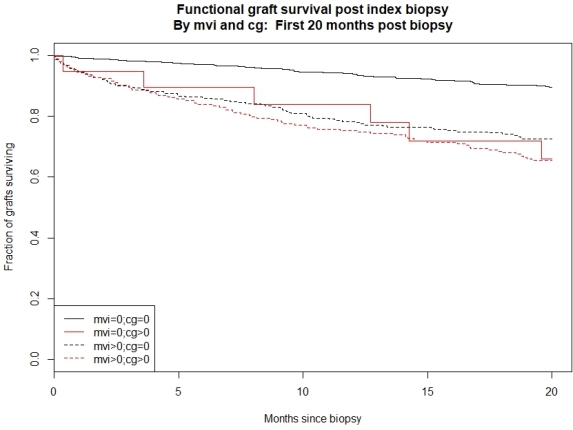Components of Microvascular Inflammation (MVI) in Kidney Transplant Biopsies (KTxBX) Impacting Late Death Censored Graft Failure (DCGF)
1Pathology, Mayo Clinic, Rochester, MN
2Int. Med., U Iowa, Iowa City, IA
3Biostatistics and Surgery, U Minnesota, Minneapolis, MN.
Meeting: 2018 American Transplant Congress
Abstract number: B176
Keywords: Biopsy, Inflammation, Kidney transplantation, Multicenter studies
Session Information
Session Name: Poster Session B: Kidney Living Donor: Long Term Outcomes
Session Type: Poster Session
Date: Sunday, June 3, 2018
Session Time: 6:00pm-7:00pm
 Presentation Time: 6:00pm-7:00pm
Presentation Time: 6:00pm-7:00pm
Location: Hall 4EF
Recent studies document that MVI increases DCGF. However, the relationship between components of MVI (Banff scores g, cg, ptc) and macrovascular inflammation (v) have not been rigorously examined in a large patient cohort. We sought to define the relationship between g, cg, ptc, and v and their impact on DCGF.
Methods: Patients were enrolled in DeKAF, a multicenter study of late renal allograft outcome. A prospective cohort (PC) included 606 patients enrolled at transplant who subsequently underwent KTxBx for increase in serum creatinine (Scr) or new onset proteinuria; the cross-sectional cohort (CSC) included 489 patients with stable graft function up to Jan 2006 who subsequently underwent KTxBx for increased Scr or proteinuria; patients with biopsies showing BK virus or recurrent glomerulonephritis were excluded. KTxBx were read by a central pathologist in blinded fashion according to expanded Banff criteria. Patients with biopsies showing BK virus or recurrent disease were excluded from analysis.
Results: DCGF for the first 20 months following KTxBx was identical in both cohorts. MVI scores (g, cg, ptc) >0 were more frequent in the CSC than the PC. Only 5% of biopsies (58/1095) had v scores >0, but they were more frequent in PC. MVI scores (g, cg, and ptc) were all highly correlated with each other; v scores were weakly correlated with MVI. By univariate Cox analysis, g>0, ptc>0, and cg>0 all increased hazard for DCGF, but in none of these was there further increase in hazard with scores > 1, nor was the hazard increased when more than one of ptc, g, or cg was >0. In the presence of MVI (ptc>0 or g>0), graft survival was similar whether cg=0 or cg>0 (Figure).
Conclusions: Any MVI >0 led to a similar increase in hazard of DCGF. With MVI present, cg >0 had no further impact on DCGF. Our findings underscore the importance of any MVI on graft survival. MVI should be diagnosed with any ptc, g, or cg >0. The results also call into question the distinction between acute and chronic MVI based on cg >0.
CITATION INFORMATION: Grande J., Hunsicker L., LeDuc R., Matas A., The DeKAF Consortium Components of Microvascular Inflammation (MVI) in Kidney Transplant Biopsies (KTxBX) Impacting Late Death Censored Graft Failure (DCGF) Am J Transplant. 2017;17 (suppl 3).
To cite this abstract in AMA style:
Grande J, Hunsicker L, LeDuc R, Matas A, Consortium TheDeKAF. Components of Microvascular Inflammation (MVI) in Kidney Transplant Biopsies (KTxBX) Impacting Late Death Censored Graft Failure (DCGF) [abstract]. https://atcmeetingabstracts.com/abstract/components-of-microvascular-inflammation-mvi-in-kidney-transplant-biopsies-ktxbx-impacting-late-death-censored-graft-failure-dcgf/. Accessed January 5, 2026.« Back to 2018 American Transplant Congress

